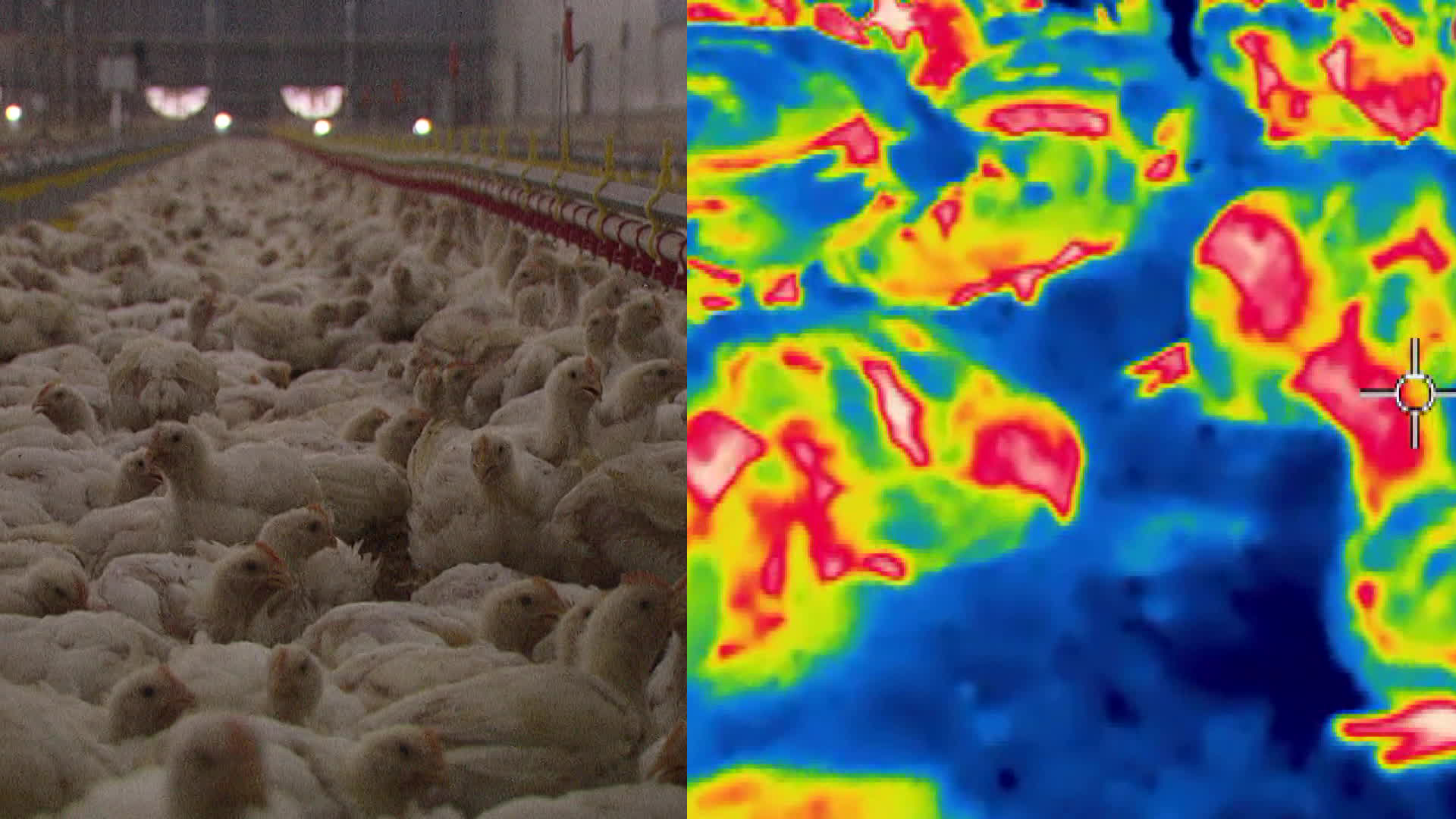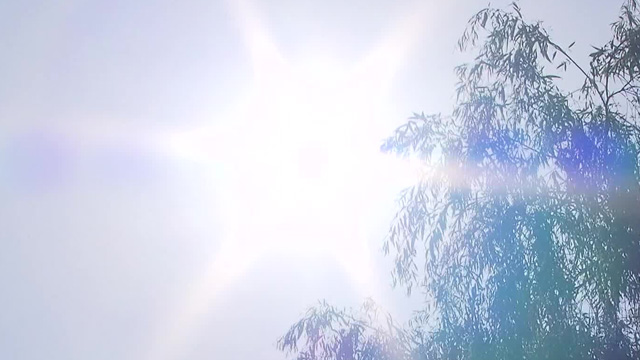[Anchor]
No business can withstand this heat, and livestock are in a state of emergency.
When a thermal camera is pointed at a poultry farm, you can clearly see how high the chickens’ body temperatures are.
As this heatwave reaches the level of a natural disaster, farmers are adjusting their response measures.
Seo Yoon-deok reports.
[Report]
A poultry farm with 66,000 chickens.
Inside the barn, the chickens are constantly drinking water from the water trough.
They are also have their mouths open to lower their body temperature.
[Ahn Wan-soon/Livestock Farmer: "They just sit still with their mouths open and pant. Right now, when the chickens are hot, they don't eat well at all."]
Chickens are vulnerable to heat because they do not have sweat glands. As the heatwave continues, urgent measures are being taken to prevent mass deaths.
To lower the barn temperature, groundwater is circulated along the outer walls to operate cooling pads, and large fans run continuously inside to cool the air.
To reduce heat stress, the number of livestock has been decreased, and supplements are being given to relieve stress, but concerns remain as to when problems might arise.
[Ahn Wan-soon/Livestock Farmer: "There could be a sudden power outage. Also, if the temperature is high, the alarm devices might go off."]
Cattle farmers are also fighting the heatwave, installing sprinklers on rooftops and applying shading materials to block sunlight.
However, this year’s heatwave has already caused over one million chickens and pigs to die nationwide, which is more than 12 times the same period last year.
The government and local governments are providing heat-related risk alerts based on regional forecasts, but livestock farmers remain anxious as they face this disaster-level heatwave.
This is Seo Yoon-deok from KBS News.
No business can withstand this heat, and livestock are in a state of emergency.
When a thermal camera is pointed at a poultry farm, you can clearly see how high the chickens’ body temperatures are.
As this heatwave reaches the level of a natural disaster, farmers are adjusting their response measures.
Seo Yoon-deok reports.
[Report]
A poultry farm with 66,000 chickens.
Inside the barn, the chickens are constantly drinking water from the water trough.
They are also have their mouths open to lower their body temperature.
[Ahn Wan-soon/Livestock Farmer: "They just sit still with their mouths open and pant. Right now, when the chickens are hot, they don't eat well at all."]
Chickens are vulnerable to heat because they do not have sweat glands. As the heatwave continues, urgent measures are being taken to prevent mass deaths.
To lower the barn temperature, groundwater is circulated along the outer walls to operate cooling pads, and large fans run continuously inside to cool the air.
To reduce heat stress, the number of livestock has been decreased, and supplements are being given to relieve stress, but concerns remain as to when problems might arise.
[Ahn Wan-soon/Livestock Farmer: "There could be a sudden power outage. Also, if the temperature is high, the alarm devices might go off."]
Cattle farmers are also fighting the heatwave, installing sprinklers on rooftops and applying shading materials to block sunlight.
However, this year’s heatwave has already caused over one million chickens and pigs to die nationwide, which is more than 12 times the same period last year.
The government and local governments are providing heat-related risk alerts based on regional forecasts, but livestock farmers remain anxious as they face this disaster-level heatwave.
This is Seo Yoon-deok from KBS News.
■ 제보하기
▷ 카카오톡 : 'KBS제보' 검색, 채널 추가
▷ 전화 : 02-781-1234, 4444
▷ 이메일 : kbs1234@kbs.co.kr
▷ 유튜브, 네이버, 카카오에서도 KBS뉴스를 구독해주세요!
- Heatwave threatens livestock
-
- 입력 2025-07-26 23:04:31

[Anchor]
No business can withstand this heat, and livestock are in a state of emergency.
When a thermal camera is pointed at a poultry farm, you can clearly see how high the chickens’ body temperatures are.
As this heatwave reaches the level of a natural disaster, farmers are adjusting their response measures.
Seo Yoon-deok reports.
[Report]
A poultry farm with 66,000 chickens.
Inside the barn, the chickens are constantly drinking water from the water trough.
They are also have their mouths open to lower their body temperature.
[Ahn Wan-soon/Livestock Farmer: "They just sit still with their mouths open and pant. Right now, when the chickens are hot, they don't eat well at all."]
Chickens are vulnerable to heat because they do not have sweat glands. As the heatwave continues, urgent measures are being taken to prevent mass deaths.
To lower the barn temperature, groundwater is circulated along the outer walls to operate cooling pads, and large fans run continuously inside to cool the air.
To reduce heat stress, the number of livestock has been decreased, and supplements are being given to relieve stress, but concerns remain as to when problems might arise.
[Ahn Wan-soon/Livestock Farmer: "There could be a sudden power outage. Also, if the temperature is high, the alarm devices might go off."]
Cattle farmers are also fighting the heatwave, installing sprinklers on rooftops and applying shading materials to block sunlight.
However, this year’s heatwave has already caused over one million chickens and pigs to die nationwide, which is more than 12 times the same period last year.
The government and local governments are providing heat-related risk alerts based on regional forecasts, but livestock farmers remain anxious as they face this disaster-level heatwave.
This is Seo Yoon-deok from KBS News.
No business can withstand this heat, and livestock are in a state of emergency.
When a thermal camera is pointed at a poultry farm, you can clearly see how high the chickens’ body temperatures are.
As this heatwave reaches the level of a natural disaster, farmers are adjusting their response measures.
Seo Yoon-deok reports.
[Report]
A poultry farm with 66,000 chickens.
Inside the barn, the chickens are constantly drinking water from the water trough.
They are also have their mouths open to lower their body temperature.
[Ahn Wan-soon/Livestock Farmer: "They just sit still with their mouths open and pant. Right now, when the chickens are hot, they don't eat well at all."]
Chickens are vulnerable to heat because they do not have sweat glands. As the heatwave continues, urgent measures are being taken to prevent mass deaths.
To lower the barn temperature, groundwater is circulated along the outer walls to operate cooling pads, and large fans run continuously inside to cool the air.
To reduce heat stress, the number of livestock has been decreased, and supplements are being given to relieve stress, but concerns remain as to when problems might arise.
[Ahn Wan-soon/Livestock Farmer: "There could be a sudden power outage. Also, if the temperature is high, the alarm devices might go off."]
Cattle farmers are also fighting the heatwave, installing sprinklers on rooftops and applying shading materials to block sunlight.
However, this year’s heatwave has already caused over one million chickens and pigs to die nationwide, which is more than 12 times the same period last year.
The government and local governments are providing heat-related risk alerts based on regional forecasts, but livestock farmers remain anxious as they face this disaster-level heatwave.
This is Seo Yoon-deok from KBS News.
-
-

서윤덕 기자 duck@kbs.co.kr
서윤덕 기자의 기사 모음
-
이 기사가 좋으셨다면
-
좋아요
0
-
응원해요
0
-
후속 원해요
0















이 기사에 대한 의견을 남겨주세요.